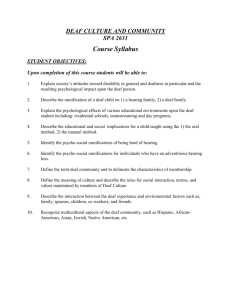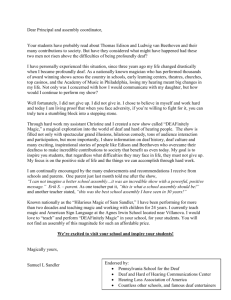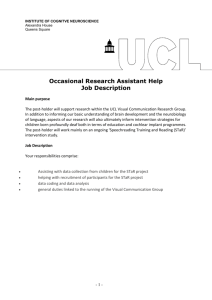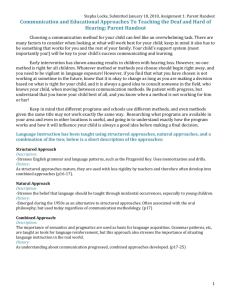Empower Learners by Improving Memory
advertisement
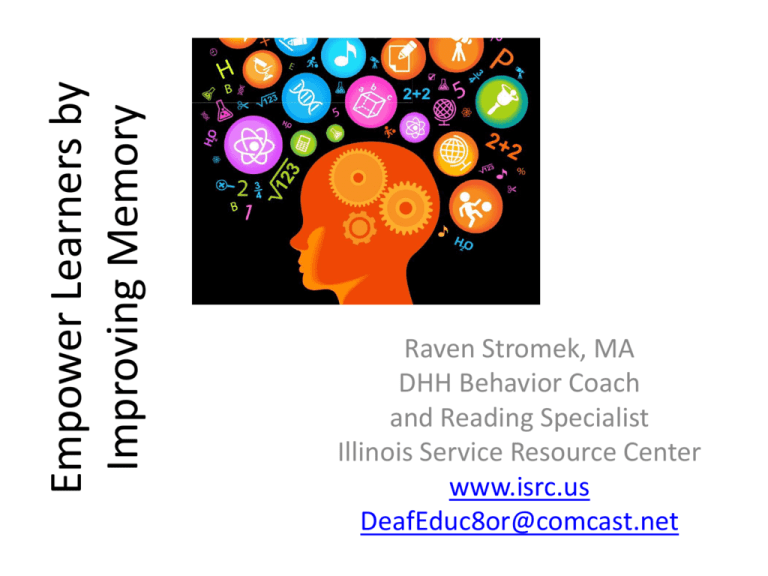
Empower Learners by Improving Memory Raven Stromek, MA DHH Behavior Coach and Reading Specialist Illinois Service Resource Center www.isrc.us DeafEduc8or@comcast.net Illinois Service Resource Center A Service and Resource Center of the Illinois State Board of Education Supporting deaf/hard of hearing student behavioral needs • • • • • • Schools/ Educators Individual student observations Data collection support DHH Behavior Team training and support School-wide positive behavior support Online training modules Mentoring www.isrc.us • • • • • • Parents/ Families Individual student home visits for behavior support Library – materials mailed with return postage Speakers for parent support groups Locate needed resources Parent Facilitators Newsletter 800-550-4772 Illinois Service Resource Center A Service and Resource Center of the Illinois State Board of Education Supporting deaf/hard of hearing student behavioral needs • • • • • Students Deaf Student Network Leadership Day Deaf Can Do It Day Deaf Teen Saturday in the City How I Advocate For Others Essay Contest www.isrc.us 800-550-4772 To accomplish today: Gain insight into Harley Hamilton’s research about memory abilities of deaf learners. Understand four specific areas of memory difficulty in deaf learners. Make connections between the areas of memory difficulty and common academic demands. Explore fun, engaging, and interactive ways to improve memory skills in deaf learners. THE RESEARCH HARLEY HAMILTON http://www.cats.gatech.edu/cats/articles/Hamilton%202011-%20WM%20skills.pdf WM and STM Working Memory • Actively processes information • How much info the students can “use” Short Term Memory • Passively holds information • How long students can “hold” the info Working memory and short term memory predict academic success in: Reading Language Comprehension Mathematics Science Deaf specific strengths and needs Weaknesses • Sequential recall • Processing speed • Attention • Memory load Strengths • Free recall • Visuospatial recall • Imagery • Dual encoding Can be strengths when used: • Phonological encoding • Rehearsal AREAS OF WEAKNESS Sequential Memory • Recall a list in the same order it was presented – Digits – Printed words – Pictures – ASL signs – Fingerspelling Processing Speed • How quickly students can perform a task – Oral and written language – Math abilities – Word recognition…thus, fluency & comprehension – Language development and processing – Strong native language base Attention • Focus on one stimuli – DoD: 14.1% ADHD; DoH: 38.7% ADHD – Deaf better at peripheral than hearing – Directing and sustaining attention is difficult • Deaf attend to signing peers in class discussion 30% • Deaf attend to signing teacher 44%, 1:1 attention 50% Memory Load • How difficult a task is – cognitive complexity • Harder the task = decrease in performance • Hearing example – 8 word sentence harder than 3 word sentence – 8 word tongue twister harder than simple control • Deaf example – Cherological: sign-based formational features – Comprehension down for formationally similar – I ate apples at home yesterday…ATE APPLES HOME YESTERDAY – Memory load increase problematic for Deaf sooner than hearing AREAS OF STRENGTH Free recall • Recalling a list, any order • Equivalent recall for: • • • • printed words ASL/spoken words Line drawings Sequentially presented shapes • Helpful for names of states, parts of body, etc. Visuospatial Recall • Objects presented in visual array – Blocks on a table, objects in a grid • Superior to hearing: – Recall info presented in static format for linguistic and nonlinguistic – Touch blocks in same order random or straight arrangements – Everyday objects on a grid Visuospatial Recall cont’d. • Same/similar as hearing – Simon game – Recall series of geometric shapes (draw) - simple or complex – Line of shapes all at once (But not shapes presented one at a time that disappear before next is shown) Imagery • Make, sustain, and manipulate visual image • Enhanced over hearing: – Imagery: creating a picture in his/her head – Mental rotation Dual Encoding • Use both sign and speech (SimCom) • Better than hearing: – List of words • Problem is skill level of SimCom users Memory strengths if strategy is taught and used • Phonological encoding (speech based) • Speech reading, articulatory gesture (cue, VP) = phonological signal in brain • Some deaf develop/use, some not • Less likely than hearing to use for phonological encoding, reading, spelling • When used helps: – sequential recall – reading comp Memory strengths if strategy is taught and used • Rehearsal: Overt or covert repetition of items to remember • Deaf need overt to show benefit: – Printed words – Images – Signed phrases • Deaf do not naturally use as early as hearing – D 10 yrs. H 7-8 yrs. IMPLICATIONS Implications • All related to skills needed to comprehend and learn language • Attention: acquire language in environment • Processing speed: encode and manipulate • Memory load: stressed from lack of automatization reduces processing speed • Sequential linguistic info needed for cognition Implications • Strengths can be used to improve instruction for DHH students • Can be used to improve deficiencies • Need specific strategy instruction Early Childhood through age 15 yield best results INTERVENTIONS AND STRATEGIES Early Childhood • Early exposure to fluent language models – Slow, clear, short sentences – Videos, videogames • Rehearsal – Nursery rhymes, songs, chants, actions • Household tasks – – routines, sequencing, simple directions, • ASL mechanism of referencing items on a list • Free recall – items on shopping list • Watch signed sentence, sequence pictures to depict meaning • Formationally similar signs increase memory load, dissimilar decrease difficulty • Print, static stimuli • Sequencing and retelling stories • Imagery and comprehension – generate a sentence, draw it, switch out nouns, repeat • Automaticity – drill vocabulary – PPT on set timer, white board and cover/erase • Processing speed – captioning • Online dictionaries – SMARTSign-Dictionary, google images • Phonological development – speechreading, articulation practice, [cued speech?]…w/print • Build automatized schemas • Low error exposure through scaffolding • Simple Sentence Lab – www.cats.gatech.edu/cats/CatSoft/SSL.htm – Sequential memory, sentence production, spelling, chunking English phrases, rehearsal, and schema building for written English • Visual images with rehearsal • Rehearsal • Chunking – Fairview method: “look up”, “jump over”, “get on” • SimCom for word lists • Visual imagery • Displays for reference [Visual Information Plan] • Static sequential visuospatial presentation 2+4=6 • Fact tables • Drill for automaticity to increase processing speed and attention – white board, PPT, paper • Dictating problems • Mental math • ASL feature of referring to objects in a place • Calculators • Free recall – Labeling: states, body parts – Categorizing: habitat, culture, states of matter • • • • Rehearsal and repetition Variety of practice materials Flowcharts, boxes, diagrams Thinking maps or graphic organizers – www.free-mind.en.softonic.com – www.xmind.net General Attention • Peripheral information is STRONG with deaf – Problematic for attending/language learning – Intervention: • Stand near screen with predictable movement • Short, simple directions…then build • Teach and practice sustained attention – With and without distractions Memory Load • • • • • • • • Simple, structured, redundant language Eliminate multitasking Repeated exposure to new material Processing and rehearsal time Apply memory strategies Repetition External supports – visuals, checklists, prompts Scaffolding and errorless learning, minimize failure • ASL Working Memory • • • • • • • • Brief Focus on one strategy - well spaced Practice strategies Connect success to strategies Allow students to “overlearn” Positive Reinforcement Teach when and how – metacognition Strategy instruction needs to be aligned with student needs and growth Neurologist Recommended • Destress - enjoyable rituals • Grab attention - "advertising" or giving hints • Color - colored pens color code notes or words • Novelty - funny hat, put a scarf on the dog • Personal meaning - interests http://www.psychologytoday.com/blog/radical-teaching/200904/top-10-list-improve-your-childs-memory Neurologist cont’d. • Relational memories - connects with experiences • Patterning - Charts, mnemonics, same/different • Mental manipulation - do something with it Practice makes permanent - Review material using multiple sensory activities • “Syn-naps” = brain-breaks (depleted after as little as ten minutes) General Strategies • • • • Get the details “I’m going on a picnic and I’m bringing…” Routines/steps – daily, recipes, chores Practice remembering • • • • Visualization … silly image of what or where Chaining … story of a list Chunking … phone or CC numbers in set of 3 or 4 Acrostics … My Very Educated Mother Just Served Us Nine Pizzas General cont’d. • • • • Music, rhythm, chant Illustrations, pictures, mind maps Develop interest Study most important to remember first • Teach someone else Web resources • http://staff.washington.edu/chudler/chmemory.h tml • Short Term Memory Test. • Short Term Memory Picture Game • Play SIMON SAYS Game 1 • Play SIMON SAYS Game 2 • Face Memory Test - Version 1 • Face Memory Test - Version 2 • http://www.learninggamesforkids.com/memo ry_games/memory_games_simon.html • http://www.brainmetrix.com/color-game/ • http://www.exploratorium.edu/listen/activitie s/memory_game/deploy/activity_memoryga me.php FUN STRATEGIES Percussion • Tools and resources: – ISRC Drum Kit – Developmental Community Music (DCM) – Together in Rhythm: A Facilitator’s Guide to Drum Circle Music (Book & DVD)--Kalani (Aug 1, 2004) – Body Percussion – Make your own: rain sticks, shakers, drums • http://www.pinterest.com/ravenstromek/make-your-own-percussion/ • Follow the Leader – Leader makes up a pattern of four beats and others repeat back. Gradually increase number of beats to remember. • Pass the Percussion – First person does a pattern of three beats. The next person does that pattern and adds on. Continue. Percussion cont’d. • Generate a pattern using graphics (circle, square, triangle) that represent musical movements. Students perform the piece using the graphics; slowly remove the visual support to increase reliance on memory. • Students stand/sit facing each other…one person creates a rhythm and the other repeats the rhythm and then creates a rhythm of his/her own that their partner must then repeat and create a new rhythm of his/her own – repeat. Now You See It, Now You Don't • Tray or a large plate. (cookie sheet, cafeteria tray). • Put 10 to 20 objects on the tray, and cover. • Explain: objects on the tray, want them to remember as many as possible, one minute. • Use a timer. • Cover, Write down all they can remember. • Could they remember all of the items? Are there any items that were forgotten by all the students? • Teach some of the memory techniques and repeat the experiment. What's Missing • • • • • Variation of the previous experiment to test short term memory. Get your tray and items and cloth ready again. This time have you students view the items for 1 minute. Then cover the tray again. Without the students seeing, REMOVE 1 item from the tray. Show the tray and remaining items to your students again. Ask them, "What is missing?". Can they guess what you removed? • • • • • Further variations: more time/less time to view More/less objects on the tray. Try it with fewer objects, identify the missing object by feel Try it again, but this time remove 3-4 objects. Who’s Missing Have one student leave the room. While this student is out of the room, have another student hide. Then bring the first student back into the room. Can this student name the student who is missing? Classroom Mix-up • Tell everyone to take a good look around the classroom to remember where objects are located in the room. • Send a few students out of the room while you change the location of various objects in the class. • Make sure YOU keep a list of all the things that you have changed! • When the students come back into the classroom, ask them to write down or take turns telling all of the things that have changed. Everyday Memory • Go to the Exploratorium to see if you remember what this common everyday object really looks like. What can it be? What can it be? • This experiment is based on a study by Nickerson, R.S. and Adams, M.J. titled "Long-term memory for a common object," Cognitive Psychology, 11:297-307, 1979. Eye Witness • Plan to have someone (a teacher or a student) come into your class. Let's call this person, "X". X should plan on doing several things in class such as: • Change the time on the clock • Take a book and put it in a bag • Erase the chalkboard • Close a window • Talk to someone • Before X comes into the room, have all of the students working or reading at their desks. When X comes into the room, most of the students will be curious about what he or she is doing. After X leaves the room, have the students write down or tell all the things that happened. • What details do they recall? What did X wear? How long was X in the room? What book did X take? Who did X talk to? What did X say? You may even ask some leading questions to influence memory. For example, if X was not wearing a hat, ask, "What color hat was X wearing?". Compare how everyone's memory was the same and different. False Memories • • • • • • • • • Sometimes your brain makes up its own memories. Try to "implant" a memory by asking people to remember the words on list 1. Wait about five minutes, then probe their memory by asking them which words on list 2 they remember. List 1: read, pages, letters, school, study, reading, stories, sheets, cover, pen, pencil, magazine, paper, words List 2: house, pencil, apple, shoe, book, flag, rock, train, ocean, hill, music, water, glass, school Did they say that "book" was on list 1? Only pencil and school were on list 1. Try these words: List 1: sheets, pillow, mattress, blanket, comfortable, room, dream, lay, chair, rest, tired, night, dark, time List 2: door, tree, eye, song, pillow, juice, orange, radio, rain, car, sleep, cat, dream, eat Did they say that "sleep" was on list 1? Only pillow and dream were on list 1. Make up your own lists and see if you can create a false memory. Concentration • Traditional: Deck of any cards or matching sets of pictures/shapes/letters/etc laid in a grid. Match. • PLAY BRAIN CONCENTRATION • PLAY SENSORY CONCENTRATION Memory • Click the link to see 25 different objects. Look at them for 30 seconds, then click on the "Back" button to return to this page. Write down all the objects that you can remember. • Here are the 25 objects. A-maze-ing • • • • • • • • • • [Maze 1 - easy] [Maze 2 - harder] [Maze 3 - hardest] (Click on the maze, then "save" the big maze or just print it out). [Or use other mazes you have.] Get at least 3 copies of each maze. Time it takes you to complete the maze...from "START" to "FINISH" Record the amount of time it takes you. Then, do the SAME maze over again on a new copy. Record the amount of time it takes you to complete it. Then do it a third time and even a fourth time if you want. iPad Games • • • • • • • • • • Flow Free Just Find It My First Games: Spot the Difference Labyrinth 2 HD Lite TanZen HD Lite My First Puzzles Crazy Copy Games HD Free Lite Air Hockey Gold (Mazes – but any good ones are $$) Search “memory” Board Games and Puzzles • • • • • • • • • • • Tribond Memory Concentration Sequence Uno Blink Battleship Connect 4 Checkers (chess) Brick by Brick Mind Trap • • • • • • • Dot to Dot Mazes Word search Sudoku Crossword Word Search Jig saw puzzles • Think Fun Games: Visual Brain Storms, Rush Hour, Swish, Roll and Play, Amaze, Distraction References • http://www.parents.com/toddlerspreschoolers/development/intellectual/enhancechilds-memory/ • http://www.parents.com/kids/development/intel lectual/improve-kids-memory-skills/ • http://www.cyh.com/HealthTopics/HealthTopicD etailsKids.aspx?p=335&np=152&id=2431 • http://www.oxfordlearning.com/2006/05/16/10ways-to-build-your-childs-memory/ • https://faculty.washington.edu/chudler/chmemo ry.html Raven Stromek DHH Behavior Coach and Reading Specialist Illinois Service Resource Center www.isrc.us DeafEduc8or@comcast.net




